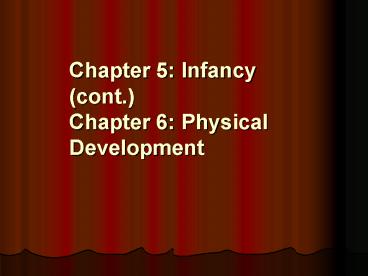Chapter 5: Infancy cont' Chapter 6: Physical Development - PowerPoint PPT Presentation
1 / 31
Title:
Chapter 5: Infancy cont' Chapter 6: Physical Development
Description:
Deferred imitation (p. 191): The ability to reproduce a modeled ... Imitation (pp. ... and 3-week old infants imitating tongue protrusion, mouth opening, and ... – PowerPoint PPT presentation
Number of Views:153
Avg rating:3.0/5.0
Title: Chapter 5: Infancy cont' Chapter 6: Physical Development
1
Chapter 5 Infancy(cont.) Chapter 6 Physical
Development
2
Exam ReviewMonday, September 28, 8th
periodBartram 211
3
Chapter 5 Infancy(cont.) Chapter 6 Physical
Development
4
McPherson, G. E. (Ed.). (2006). The child as
musician A handbook of musical development. New
York Oxford University Press.
5
Chapter 5
- The Newborns Readiness for Life
- Newborn Reflexes
- Infant States
- Basic Learning Processes in Infancy
- Habituation
- Classical conditioning
- Operant conditioning
- Observational learning
6
Learning (p. 186) A relatively permanent change
in behavior (or behavior potential) that results
from ones experiences or practice
7
- Basic Learning Processes in Infancy
- Habituation
- Classical conditioning
- Operant conditioning
- Observational learning
8
Deferred imitation (p. 191) The ability to
reproduce a modeled action that has been
witnessed at some point in the past
9
Newborn Imitation (pp. 188-189)
10
- Figure 5.16 Sample photographs from videotaped
recordings of 2- and 3-week old infants imitating
tongue protrusion, mouth opening, and lip
protrusion.
11
Chapter 6 Physical Development The Brain, Body,
Motor Skills, and Sexual Development
12
Chapter 6
- An Overview of Maturation and Growth
- Development of the Brain
- Motor Development
- Puberty
- Causes and Correlates of Physical Development
13
Cephalocaudal development (p. 200) A sequence of
physical maturation and growth that proceeds from
the head (cephalic region) to the tail (caudal
region)
14
Proximodistal development (p. 201) A sequence
of physical maturation and growth the proceeds
from the center of the body (the proximal region)
to the extremities (distal regions)
15
Chapter 6
- An Overview of Maturation and Growth
- Development of the Brain
- Motor Development
- Puberty
- Causes and Correlates of Physical Development
16
Synaptogenesis (p. 204) Formation of connections
(synapses) among neurons
17
Plasticity (p. 204) Capacity for change a
developmental state that has the capacity to be
shaped by experience
18
Bruer, J. T. (1999). The Myth of the First Three
Years A New Understanding of Early Brain
Development and Lifelong Learning
19
Motor Development
20
Motor Development
- Nature-Nurture
21
Motor Development
- Nature-Nurture
- Normative-Idiographic
22
Motor Development
- Nature-Nurture
- Normative-Idiographic
- Dynamic systems theory (p. 211)
23
Motor Development
- Nature-Nurture
- Normative-Idiographic
- Dynamic systems theory (p. 211)
- Implications for other developments
24
Exam ReviewMonday, September 28, 8th
periodBartram 211
25
- Office Hours
- VD Monday 5th
- SM Monday 6th 7th
26
- Exam
- 50 points
- 30 multiple-choice1 point each
- 10 of 12 of definitions2 points each
27
Of 30 multiple-choice, 3 from text only, 3 from
lecture only, 24 from both sourcesOf 12
definitions, 2 from text only, 2 from lecture
only, 8 from both sources
28
Most heavily weighted Chapter 2Theories
29
Most heavily weighted Chapter 2TheoriesNext
most Chapter 1Methods Chapter
5Infancy
30
Definitions
- No genetic diseases (Chapter 3)
- No specific teratogens (Chapter 4)
- No specific reflexes (Chapter 5)
31
Test Tips
- Use the time
- Definitions neednt be verbatimwhen studying,
put in own words. - When in doubt, put more rather than less.
- Concentrate on topics covered in both text and
lecture. - And in lecture only.































